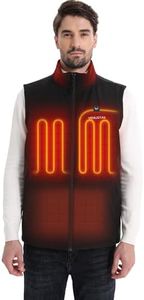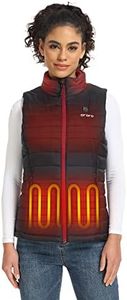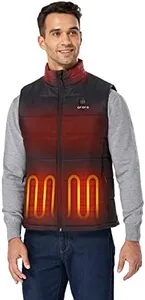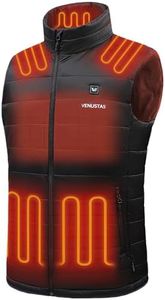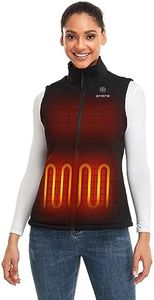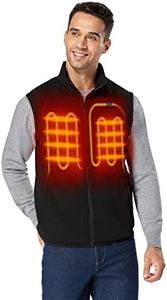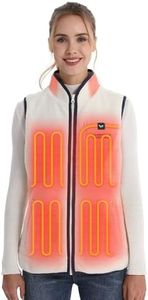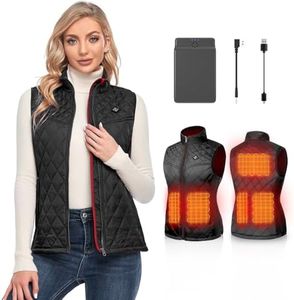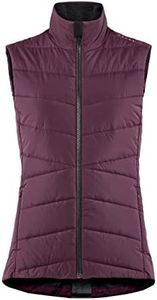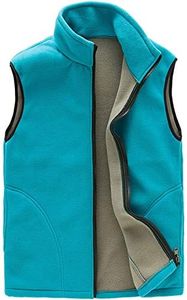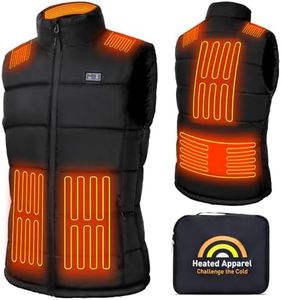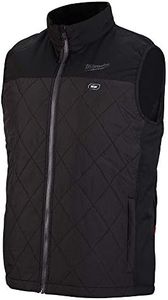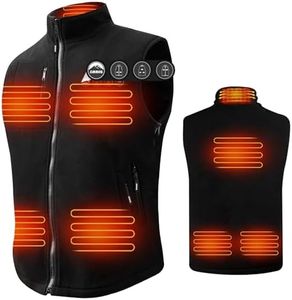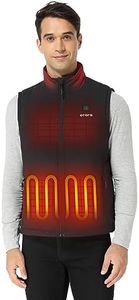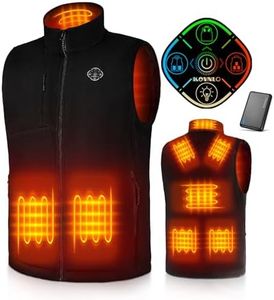10 Best Heated Vests 2025 in the United States
Our technology thoroughly searches through the online shopping world, reviewing hundreds of sites. We then process and analyze this information, updating in real-time to bring you the latest top-rated products. This way, you always get the best and most current options available.

Our Top Picks
Winner
ORORO Women's Lightweight Heated Vest with Battery Pack (Black,S)
Most important from
10437 reviews
The ORORO Women's Lightweight Heated Vest offers an impressive combination of warmth, comfort, and practicality. This vest features four carbon fiber heating elements strategically placed across the collar, mid-back, and underneath two pockets, ensuring comprehensive body warmth. The material is a water and wind-resistant 100% nylon fabric, making it ideal for various weather conditions. With three adjustable heat settings, users can easily find their preferred temperature with the press of a button.
The vest heats up quickly and can deliver warmth for up to 10 hours on a single charge, which is convenient for extended outdoor activities. Additionally, the included battery pack has a USB port for smartphone charging, adding a layer of practicality. The fit is designed to be neat and tailored, allowing for unrestricted movement and versatility in how it can be worn, making it suitable for daily use or as an extra layer under a winter coat.
Safety and durability are also prioritized, with the heating elements and vest construction designed to withstand over 50 machine wash cycles. However, users may need to consider the fit, as sizing can sometimes be tricky with vests. Also, while the battery life is good, the need to recharge could be a minor inconvenience for some. This vest is a great choice for anyone looking to stay warm during colder months, whether for daily commuting, outdoor activities, or even just staying comfortable in a cold office.
Most important from
10437 reviews
ORORO Men's Lightweight Heated Vest with Battery Pack (Charger Not Included) (Black,S)
Most important from
10951 reviews
The ORORO Men's Lightweight Heated Vest is designed with four carbon fiber heating elements placed in the collar, mid-back, and pockets, ensuring core body warmth. The vest offers three heat settings, easily adjustable with a press of a button. Its 7.4V UL/CE-certified battery provides rapid heating and up to 10 hours of warmth on a single charge, which is convenient for various activities, from a daily commute to outdoor sports. The vest also includes a USB port for charging smartphones, adding an extra layer of functionality.
Made from 100% nylon, it is both water and wind-resistant, making it suitable for diverse weather conditions. The machine-washable feature ensures easy maintenance, with the ability to withstand over 50 wash cycles. On the downside, the lack of an included charger might be inconvenient, as it requires an additional purchase. Also, the fit and size options are not detailed, which could be a concern for those between sizes or with specific fit preferences.
For those looking for a versatile and functional heated vest, this product seems to be a robust option.
Most important from
10951 reviews
Venustas Men's Heated Vest with Battery Pack 7.4V, Ultra-thin Carbon Fiber, Suitable for Winter Outdoor Hunting Skiing
Most important from
2816 reviews
The Venustas Men's Heated Vest stands out with its 30% larger heating areas, covering vital body parts like the collar, back, shoulders, and underneath pockets for comprehensive warmth. It's powered by a 5000mAh battery that provides up to 9-10 hours of heat on the lowest setting, making it suitable for extended outdoor activities.
The vest allows for easy temperature adjustment with three heat settings (high, medium, low) through a simple button press, catering to different comfort needs. Made from 100% nylon, the vest promises breathability and unrestricted movement, ideal for various activities. Additionally, it offers the convenience of charging your phone through its USB port, adding extra functionality to the vest. It's also machine washable, making maintenance straightforward.
However, the battery life on high heat settings is relatively short, lasting only 2.5-3 hours, which might require frequent recharging during cold days. The vest's lightweight design provides comfort, but might not be sufficient as a stand-alone winter garment in extremely cold conditions. This heated vest is best suited for those who need moderate to high warmth for outdoor activities and appreciate a blend of comfort and technology.
Most important from
2816 reviews
Buying Guide for the Best Heated Vests
Heated vests are a great way to stay warm during cold weather activities without the bulk of heavy layers. When choosing a heated vest, it's important to consider several key specifications to ensure you get the best fit for your needs. These specs will help you determine the vest's performance, comfort, and suitability for your specific activities.FAQ
Most Popular Categories Right Now
